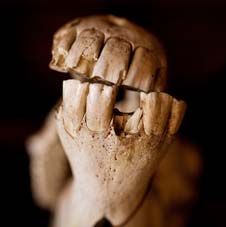Using Computers to Unlock the Secrets of Bones, Teeth and Shells
Professor Mark Rodger, Department of Scientific Computing, University of Warwick
 Horse Jaw by fotosculptor (https://flic.kr/p/7RzuLo) used under CC BY-NC 2.0
Horse Jaw by fotosculptor (https://flic.kr/p/7RzuLo) used under CC BY-NC 2.0
- Tuesday 17 June 2014, 5.45PM to 6.45pm
- Free admission
Booking required - Huntingdon Room, King's Manor, Exhibition Square (map)
Event details
![]()
Biomineralisation - the formation of mineral structures such as bones, teeth and seashells by organisms – shows how soft, organic matter can control the growth, shape and properties of hard minerals. Biominerals are often very different from synthetic minerals. While a crystal of calcite (calcium carbonate) precipitated in the laboratory has a regular, geometric form, in the spines of a sea urchin a calcite single crystal is sponge-like, with curved surfaces replacing flat crystal planes. Biominerals are also almost always composites – soft organic molecules are embedded within the crystal. It is this structure that gives biominerals such wonderful mechanical properties – indeed, tooth enamel is one of the hardest materials known.
Soft matter not only affects the properties of biominerals, but controls almost every stage of their formation - from the earliest stages of nucleation, through growth, to production of the final biomineral. Insoluble organic molecules define the special environments in which biominerals form and nucleate, while small, soluble organic molecules bind to a crystal during growth, influencing its shape. This talk will show how both experiment and molecular simulation can be used in a unique way to shed light on the fundamental mechanisms behind this most fascinating and essential capability of living organisms and how impacts on a range of subjects from archaeology to climate change and designing new materials.
About the speaker:
Mark Rodger received his BSc and PhD from the University of Sydney during the 1980s. After a postdoctoral fellowship at the University of Cambridge with Professors A J Stone and D J Tildesley, and a term in the British Gas R&D labs, he took up an academic position at the University of Reading. He moved to the University of Warwick in 1999, where he is now Professor of Molecular Simulation. A major theme of his research is how to exploit statistical mechanics and computer simulation in understanding, and thereby controlling, crystal nucleation and growth.
Accessibility
![]()
Wheelchair accessible by lift
Tickets
You may also like...
This event is part of the Science out of the Lab festival theme. Also in this theme:

